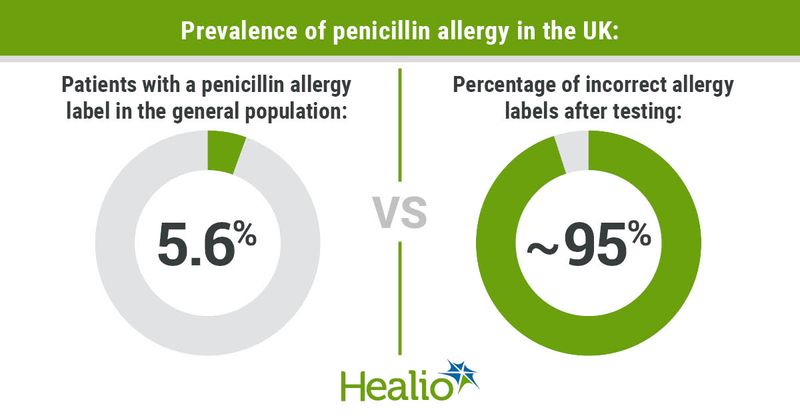Guidelines describe how non-allergists can de-label penicillin allergies
Key takeaways:
- Although 5.6% of the general population in the United Kingdom has a penicillin allergy label, about 95% of these labels are proven to be incorrect when they are tested.
- Enabling non-allergist health care professionals to conduct allergy de-labeling would expand these services at scale across the National Health Service.
- The guidelines are the same for adults and children, with age-appropriate dosing, in a hospital setting.
The British Society for Allergy and Clinical Immunology has released guidelines for clinicians in the U.K. who are not trained in allergy or immunology to evaluate and test patients with an unsubstantiated label of penicillin allergy.
Such clinicians may wish to develop a penicillin allergy de-labeling service for their patients, as 5.6% of the general population in the U.K. has a penicillin allergy label, although about 95% of such labels are incorrect when tested, Louise Savic, MD, consultant anesthetist, department of anesthesia, Leeds Teaching Hospitals, NHS Trust, and colleagues wrote in the guidelines, which were published in Clinical & Experimental Allergy.

The guidelines include appropriate patient selection, risk stratification, minimum safety standards, conduct of a drug provocation test (DPT) and the degree of oversight that allergy or immunology specialists should provide. Also, these guidelines apply to adults in the hospital setting and do not apply to patients with other beta-lactam allergies.
Non-allergists providing de-labeling services can include allied medical health care workers such as pharmacists, nurses and associate physicians in a hospital setting who work under immediate or remote medical supervision. The non-allergists who provide this de-labeling service should be networked with an allergy immunology service that will provide advice and support.
First, the guidelines state that all patients who have a penicillin allergy label in secondary or tertiary care should be considered for allergy testing and undergo risk stratification based on a detailed drug allergy history. Patients with minor gastrointestinal upset, nausea, headache or a family history of penicillin allergy without a personal history do not require allergy testing, according to the guidelines, as these symptoms are not predictors of penicillin allergy. Patients who seek reassurance of their tolerance to penicillin, however, may receive a single dose DPT, the guidelines continued.
Second, patients who have been identified with a low risk for true penicillin allergy and who do not meet any of the exclusion criteria should be offered direct DPT, which non-allergists would provide in a setting where anaphylaxis and other allergic reactions could be treated. DPTs should use the penicillin that was involved in the index reaction, with amoxicillin used when the original penicillin involved in the reaction is unknown.
Non-allergists providing de-labeling services should consider prolonged DPTs involving multiple doses after the second or subsequent dose of a course of penicillin or when the timing of the reaction is unknown.
Finally, most patients can receive a prolonged DPT of 3 days where indicated. When patients report that their index reaction happened more than 3 days after receiving penicillin, non-allergists providing the de-labeling service should consult their local or regional allergy service about how long they should extend the DPT.
Recommendations for children and adults are the same, although doses of medication should be adjusted for age, the authors wrote. Also, the authors cautioned that these guidelines do not support DPT in primary care for children.
The U.K. does not have any current defined pathway or governance framework to support penicillin allergy de-labeling, the authors noted. But because these guidelines allow a significant proportion of patients to be de-labeled outside of specialist allergy clinics, they could support testing at-scale within the National Health Service, the authors continued.
Also, these de-labeling procedures may be less costly and more acceptable for patients because they are less invasive, the authors wrote.

